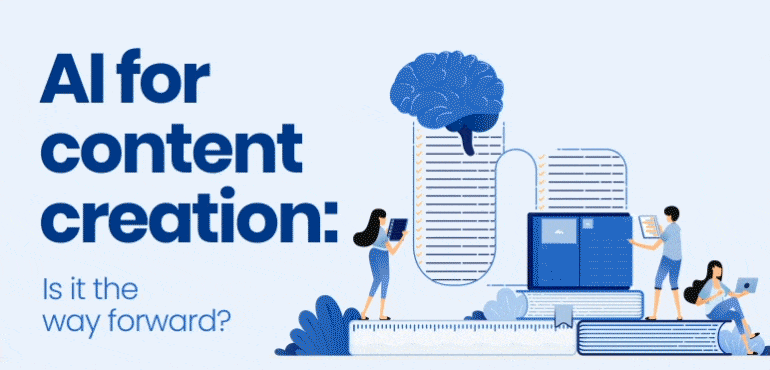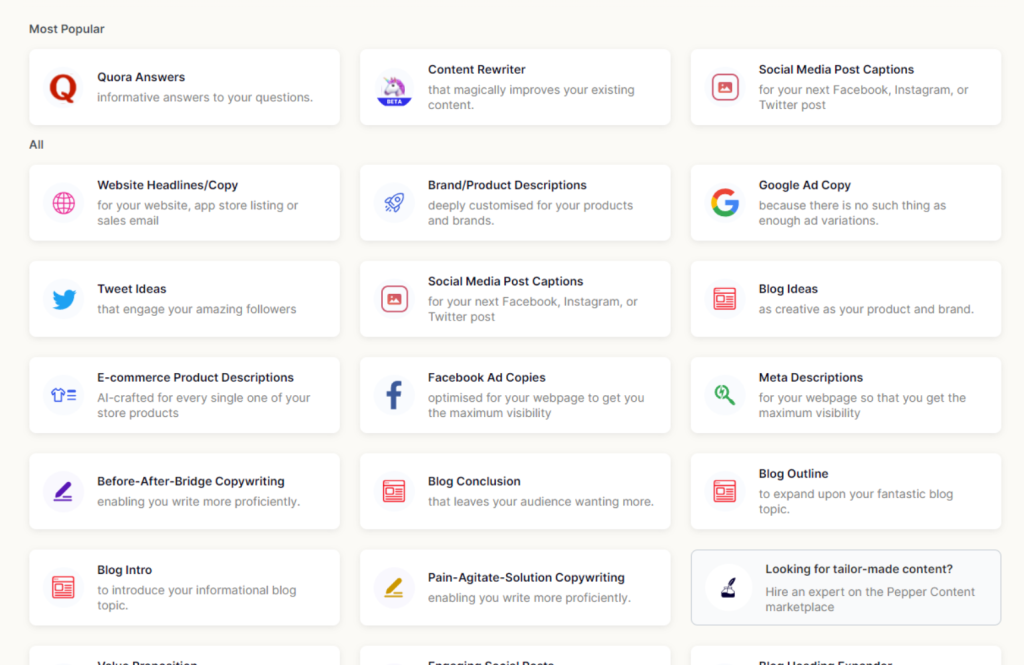AI for content creation: is it the way forward?

Article topics
- What is AI?
- The benefits of AI for content creation
- The disadvantages of AI for content creation
- Will I be penalised if I use AI to create content?
- Ready… steady… AI!
- 1. Simplified
- 2. Zyro
- 3. Peppertype
- In summary: is AI the future of content creation?
Writing blogs and webpage content can take a long time. You have to carry out research, write the content and then proof and edit it at the end.
However, what if you could press a button, and a blog post magically appeared, ready to use?
This may sound like futuristic science fiction, but artificial intelligence (or AI) means we can do this now! Many businesses use AI to quickly create copy for people to read. The question we have… is AI any good for writing content?
In this article, we’ll look at how AI can be used to write website copy, as well as give some popular AI tools a try.

What is AI?
AI refers to computers and machines that imitate human intelligence when it comes to performing tasks.
Artificial intelligence is all around us, from the smart speakers we use at home to the automated chatbots we talk to on eCommerce sites.
From a content creation perspective, AI means using machines to create blogs, articles, and website content on our behalf.
Many businesses are realising that they can use AI to move their businesses forward, with 83% of companies prioritising artificial intelligence in their business strategies.
The benefits of AI for content creation
The main advantage of AI is that it saves you time. An AI tool can create a long-form blog for you in minutes; great if you need an article in a hurry.
Many AI platforms are low-cost and no-cost. This means that if you can’t afford a copywriter, whether in-house or through an agency, you’re not restricted when creating content.

The disadvantages of AI for content creation
The key disadvantage of AI is that you’re relying on a computer to create content instead of a human writer. Unfortunately, this means you may end up with stilted content that doesn’t resonate with your target audience.
It might be that you have to invest additional hours into rewriting your AI content to make it suitable for people, meaning you lose out on any time you might have originally saved.
Will I be penalised if I use AI to create content?
One of the questions our clients often ask us is if they’ll receive an SEO penalty for using AI tools to write content for their websites.
The answer is… it depends!
Search engines like Google have always been against low-value content that doesn’t help the user. Google’s Helpful Content update, which was rolled out earlier this year, reiterates that businesses should create content for people, not search engines.
So if your AI content provides value and is well-written, it will rank well in the search engines. However, if it’s been created for the sole purpose of ranking, it may very well be penalised.
Ready… steady… AI!
We couldn’t create an article looking at the pros and cons of AI without trying it for ourselves.
So, we decided to put AI to the test and see if it could write a solid intro for one of our existing blog posts: Is a guest checkout the right choice for your eCommerce store?
We tried three popular AI programmes: Simplified, Zyro, and Peppertype.

1. Simplified
Simplified offers a comprehensive AI experience for marketers. As well as creating content, it can generate images and put together social media posts.
The free package lets you create up to 1,000 words of content a month – more than we needed for this experiment.
Simplified lets you choose from various templates, everything from blog introductions to emails and Amazon listings. One of the things we like about Simplified is that you can select the tone of voice of the content and include any specific keywords you want to feature.
Simplified came up with a few intro suggestions, but this is the one we liked the most:
The guest checkout is a staple of online shopping, but is it the right choice for your eCommerce store? The answer may surprise you.
There are a number of reasons to consider a guest checkout for your store. First, it can simplify the checkout process for your customers. Second, it can increase conversions by making it easier for customers to complete their purchase. Finally, it can provide valuable data about your customers that you can use to improve your store.
Of course, there are also some downsides to guest checkout. For example, it can lead to abandoned carts, and it can make it difficult to upsell or cross-sell products.
Ultimately, the decision of whether or not to offer a guest checkout is up to you. Weigh the pros and cons and make the choice that is right for your store.
There were a few things we weren’t keen on; for example, the ‘this answer may surprise you’ is a little clickbaity. However, this intro was good as it went into the advantages and disadvantages of guest checkouts and used eCommerce terminology like upselling and cross-selling. This was something we weren’t expecting.

2. Zyro
Like Simplified, Zyro offers a suite of web tools; one of the most interesting is an image upscaler, which uses AI to enhance low-res images.
The AI content generator is more downplayed than the rest of the examples in this article. To use it, you enter a few sentences, and Zyro comes back with some content to use.
Here’s what Zyro ended up giving us:
Is a guest checkout the right choice for your eCommerce store? The best deals are easy to find, too!
So let’s go and buy some tickets. No need of you spending money just because it seems that good offers were there already or something like this; here is what happened after I bought my first ticket:
It was in July 2011 now (the year I started writing), so things have changed since then. When I had opened my shop in December 2003 I didn’t even know anyone but myself who has purchased our product before – other than us two brothers, so we would spend hours researching products when searching online 🙂
This content wasn’t on the mark as it didn’t talk about guest checkouts and rambled on about eCommerce – not something we’d be happy to use on our site. The spelling and grammar were also poor-quality.
However, it was interesting to see that the content was created in the first person and used anecdotes in the way that an actual person would write. Given that one of the disadvantages of AI content is that it doesn’t sound like humans created it, the Zyro content seemed more casual and emotive.

3. Peppertype
Peppertype promotes itself as a ‘virtual content assistant’ and prides itself on its high-converting copy – it even claims that its homepage is written using AI!
Like Simplified, Peppertype offers many different templates to get you started and even has a ‘content rewriter’ that enhances your existing content.
The content creation process is similar to Zyro in that you enter some sentences, and Peppertype uses your input to generate your blog intro.
Again, Peppertype produced a few suggestions, but this is the best one offered.
Most eCommerce stores today have an option to sign up or checkout as a guest. This feature lets customers have a smooth experience without requiring them to create an account.
Guest checkouts do more for your store than just improving the experience of your customers. This blog will look at the different ways how a guest checkout can help your store.
This intro was okay, but it was short and lacked the detail that Simplified went into. There was also a little repetition (although, of course, you’re encouraged to make changes to the intro until it’s right for your needs.)
Peppertype and Simplified recommend that you run the content creation system several times before getting the desired results. In our experience, the more information you can provide and the clearer the steer, the better the final article will be.
Our final scores? We’d give Simplified 8 out of 10, Peppertype 6 out of 10, and Zyro 2 out of 10.
In summary: is AI the future of content creation?
We were surprised by the result of our experiment; one of the AI content creation systems performed a lot better than we expected!
However, we’ll stick with writing our own content for the Xigen website for the time being.
The primary issue we’ve found with AI content, especially in technical niches like digital marketing and web development, is that it doesn’t go into the right amount of detail. As a result, you need to manually provide any statistics you want to include, as well as links to other pages on your site.
If you just want simple content, for example, a basic article to get backlinks from a news aggregator website, AI may save you valuable time.
Many AI providers include a ‘blog outline’ option which offers the best of both worlds. You can use AI to create headings for your content, and then fill in the gaps yourself.
Where do you stand when it comes to AI content? Let us know on social media!
Want to know more about all things digital marketing? Check out the rest of our blog.


 Back
Back